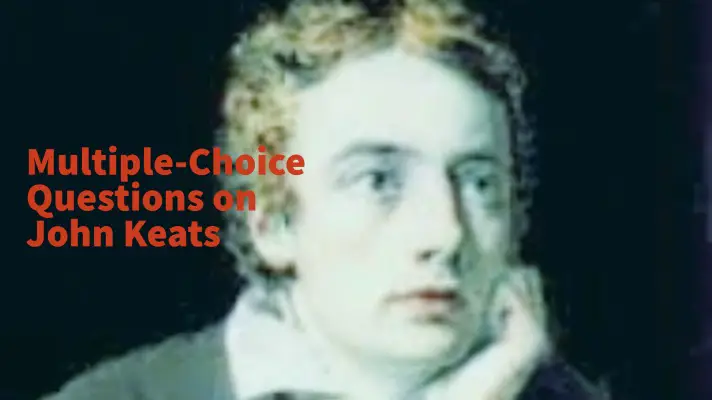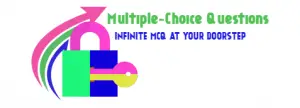Nowadays, Multiple-Choice Questions play an important role in all competitive examinations along with in-school examinations. Here, I will show you some Multiple-Choice Questions on John Keats.
At the end of this article, you will also find a PDF downloadable button from where you can download the PDF format of this MCQ sheet. So now let’s jump into the questions.
In the last section, there will be a Quiz for you.

MCQ on John Keats
John Keats quiz
- In which year John Keats was born?
- 1759
- 1795
- 1812
- 1821
Ans: (2)
- In which year did John Keats pass away?
- 1759
- 1795
- 1812
- 1821
Ans: (4)
- How old was John Keats when he passed away?
- 25
- 52
- 28
- 82
Ans: (1)
- Keats passed away as he was suffering from
- Tuberculosis
- Malaria
- Anemia
- None of these
Ans: (1)
- The first poem written by John Keats is:
- Ode to a Nightingale
- The Sonnet o Solitude
- To Autumn
- The Eve of St. Agnes
Ans: (2)
- Keats was buried in
- London
- Rome
- Finland
- Scotland
Ans: (2)
- The name of John Keats’ Father was:
- George Keats
- Frances Mary Keats
- Thomas Keats
- Milton
Ans: (3)
- Who among the following was the mother of John Keats?
- George Keats
- Frances Jennings
- Thomas Keats
- Frances Mary
Ans: (2)
- John Keats was buried in:
- Protestant Cemetery
- Brompton Cemetery
- None of these
- Unknown
Ans: (1)
- Who among the following was the younger sibling of John Keats?
- George Keats
- Frances Mary Keats
- Thomas Keats
- Milton
Ans: (1)
- The poem –“The Bright Star” was first composed for:
- Frances Mary Keats
- Frances Jennings
- Fanny Brawne
- Isabella Jones
Ans: (4)
- Later, John Keats revised the poem –“The Bright Star” and gave it to:
- Frances Mary Keats
- Frances Jennings
- Fanny Brawne
- Isabella Jones
Ans: (3)
- The Eve of St. Agnes was written by Keats in the year:
- 1817
- 1819
- 1821
- 1823
Ans: (2)
- Find the odd one out:
- To Autumn
- To psyche
- The Excursion
- On Melancholy
Ans: (3). “The Excursion” was written by William Wordsworth
- Which types of elements were written by John Keats?
- Sonnets
- Odes
- Epics
- All of the above
Ans: (4)
- “Truth is beauty, beauty is truth”- first told by:
- William Wordsworth
- Thomas Keats
- John Keats
- Shakespeare
Ans: (3)
- At which age did John Keats lose his father?
- 5
- 8
- 13
- 16
Ans: (2)
- All the greatest poetry was written by John Keats over the year:
- 1815
- 1817
- 1819
- 1820
Ans: (3)
- In which of the following Poem, does Keats say-“ A thing of beauty joy forever”?
- Endymion
- Fancy
- To sleep
- None of these
Ans: (1)
- “O for a life of sensations rather than the thought” – said by:
- Thomas Keats
- Fanny Browne
- John Keats
- Shelley
Ans: (3)
- In which of the following, Keats had written –“ O for a life of sensations rather than the thought”?
- In one of his Poem
- In one of his letter
- In one of his Epic
- None of these
Ans: (2)
- In the above question, the letter was written to
- Thomas Keats
- Fanny Browne
- Benjamin
- None of these
Ans: (3)
- The title of the Elegy written by Shelley on the death of Keats is:
- Lycidas
- Adonais
- Thyrsis
- None of these
Ans: (2)
- Keats said about himself that his name was written in water. He said this because:
- He had no hope of being remembered as a poet
- Of his frustration in love
- He suffered from the disease of consumption
- None of these
Ans: (1)
- In Adonais, Shelley told that she had dipped the pain in consuming fire for Keats’ destroyers. Here, the destroyers were:
- The editors of the quarterly review
- The editors of Blackwood’s Magazine
- Both (1) and (2)
- None of these
Ans: (3)
- Keats began his career as a/an:
- Apprentice to an apothecary
- Clerk in office
- Schoolteacher
- Sub-editor of a local newspaper
Ans: (1)
- Which of the following poem of Keats was modeled on Milton’s Paradise Lost in style and structure?
- Hyperion
- Isabella
- Endymion
- None of these
Ans: (1)
- Which of the following story discusses the elopement of two lovers?
- The ode to Nightingale
- The Autumn
- The Eve of St. Agnes
- None of these
Ans: (3)
- Which one of the following is based on “The Anatomy of Melancholy” by Burton?
- Lamia
- Isabella
- Hyperion
- None of these
Ans: (1)
- The title of “ Pure Poet” was offered to:
- Shelley
- John Keats
- Byron
- None of these
Ans: (2)
- Who was associated with “Hellenism”?
- Keats
- Shelley
- Wordsworth
- Byron
Ans: (1)
- Who was the publisher of “Sonnet O Solitude” written by Keats?
- Byron
- Leigh Hunt
- Shelley
- Keats
Ans: (2)
- Which type of articles were written by Keats mostly?
- Ode
- Drama
- Play
- Short stories
Ans: (1)
- John Keats wrote _ a number of Sonnets.
- 41
- 51
- 61
- 71
Ans: (3)
- The name of the lover of John Keats was:
- Fanny Browne
- Fanny Keats
- Isabella
- Frances Marry
Ans: (1)
- One of Keats’ poetry is the conflict between:
- Stars and Planets
- Everyday world and Eternity
- Nature and Earth
- None of these
Ans: (2)
- The recurrent feature in the Keats’s Poetry is:
- Destruction
- Moral and lessons
- Synaesthesia
- None of these
Ans: (3)
- In which of the following works of Keats, you can notice escapism?
- Ode to duty
- To autumn
- Hyperion
- Ode to Nightingale
Ans: (1)
- Why Keats was said to be a Greek-born in England?
- He was born in Greek and lived in England
- He borrowed the theme of his literature from Greek Methodology
- He had a great fascination with Greek heroes
- None of these
Ans: (2)
- In Isabella, one of the famous works of Keats, the lovers are Isabella and _.
- Lorenzo
- Her uncles
- Her foster father
- None of these
Ans: (1)
- Who killed Lorenzo in “Isabella”?
- Lorenzo’s brother
- Isabella’s brother
- Isabella’s friend
- None of these
Ans: (2)
- The story of Endymion written by Keats was taken from:
- Italian folk
- Irish legends
- Greek Methodology
- None of these
Ans: (3)
- The La Belle Dame Sans Merci of Keats is a:
- Ballad
- Song
- Sonnet
- Lyric
Ans: (1)
- Maximum poems written by Keats in 1817 was dedicated to:
- Leigh Hunt
- Wordsworth
- P.B.Shelley
- Byron
Ans: (1)
- Who published the first poem of Keats in 1816?
- Shelley
- Keats himself
- Leigh Hunt
- None of these
Ans: (3)
- In the “Ode to a Nightingale”, Keats wrote: “Where youth grows pale, specter think and dies”. Whose death was talked about?
- His brother’s death by consumption
- Death of his mother
- Death of Thomas Keats
- Death of Philip Sydney
Ans: (1)
- Hyperion presented was between:
- Gods and Evils
- Titans and Olympians
- Saturn and Archangels
- None of these
Ans: (2)
Quiz on John Keats
Here is the Quiz on John Keats for you:
Conclusion
The multiple-choice questions on John Keats mentioned here will help you in different types of competitive examinations on English Literature. If you like this article please let me know by writing in the comment box and also write if you want MCQ questions on some other topics. Best wishes!


Very helpful !
Very helpful thank you so kuch
Thank you very much for such questionnaire and the quiz. Kindly add more questions in the quiz
Thank you sir